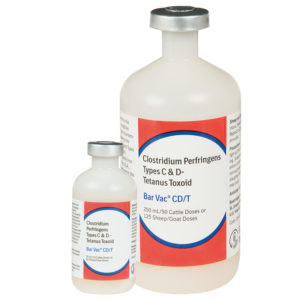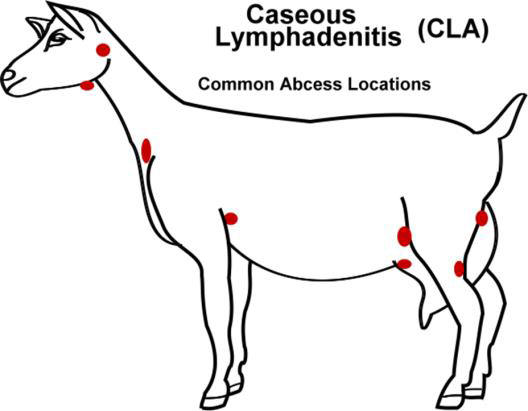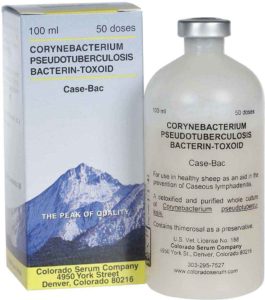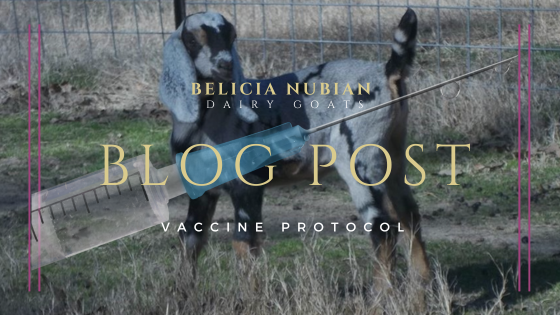Vaccine Protocol
We are commonly asked what vaccines that we use for our herd and when they are given. Below is our vaccine protocol.
Enterotoxemia, or overeating disease, is a major cause of death of kids and lambs from shortly after birth through the entire feeding period. It is caused by a bacterium called Clostridium perfringens. It is characterized by acute indigestion, convulsions and other nervous system signs such as colic and sudden death. It commonly affects single kids and lambs, nursing dams that are heavy milkers, and feeder animals that are on high energy diets. With proper feeding, management, and immunization, the disease can be controlled. Does should be vaccinated for CDT approximately 30 days prior to giving birth to provide protection to the kids through the first milk, or colostrum. This is known as passive immunity. If the doe has not been given a priming booster of two shots administered three to four weeks apart at some time in her life, the pre-kidding annual shot will not be effective. This priming set of shots is usually given when the doe is a young kid but can be done at any age.
The vaccine commonly known as “CDT” or “CD&T” is a vaccination for Clostridium perfringens type C + D and tetanus. This is the vaccine that everyone raising goats should use.
We administer a CD&T vaccine to all does 30 days prior to kidding, as mentioned above.
At 30-45 days parturition, we vaccinate each kid with CD&T. The injection is sub q (subcutaneous – under the skin) and we prefer to give it in the elbow area. The skin in the elbow area is usually loose on a kid and they don’t tend to act as if you’ve killed them by administering it there. According to the vaccine label instructions, we give a second dose in four weeks, then annually thereafter.

Caseous lymphadenitis (CL)
According to the Merck Veterinary Manual, Caseous lymphadenitis (CL) is a chronic, contagious disease caused by the bacterium Corynebacterium pseudotuberculosis. Although prevalence of CL varies by region and country, it is found worldwide and is of major concern for small ruminant producers in North America. The disease is characterized by abscess formation in or near major peripheral lymph nodes (external form) or within internal organs and lymph nodes (internal form). Although both the external and internal forms of CL occur in sheep and goats, the external form is more common in goats, and the internal form is more common in sheep.
The hallmark clinical finding in cases of external caseous lymphadenitis is the development of abscesses in the region of peripheral lymph nodes. Common sites of development include the submandibular, parotid, prescapular, and prefemoral nodes. Less commonly, abscessation of supramammary or inguinal lymph nodes occurs, in addition to an occasional ectopic location along the lymphatic chain. If left untreated, these lesions eventually mature into open draining abscesses. The purulent material from these lesions has no odor and varies in consistency from soft and pasty (more common in goats) to thick and caseous (more common in sheep).

Case-Bac
Case-Bac is primarily used for the vaccination of sheep as an aid in the prevention of Caseous lymphadenitis (CL) caused by Corynebacterium pseudotuberculosis. All goats at Belicia Nubians, 10-months and older are vaccinated, then given a booster thirty days later of Case-Bac. Adult goats are given an annual vaccine.
The Case-Bac vaccine is given via subcutaneous above the ribs. As per the boxes description, some goats develop an injection site knot, become sore on their feet for a week and occasionally go off their feed for about the same amount of time that they are sore. Some have asked why we give it if it can make them “off” for a week. We would much rather them have an injection site reaction, sore on their feet, or off their feed for a week than suffer the debilitating, fatal consequences of CL.
As of 2021, we no longer test for CL in the herd, as they will test positive with the concentration of a solution as determined by titration via the test from the vaccine given. Please note the vaccine is given as a preventative. Prior to giving Case-Bac, our entire herd tested negative for CL.

Caprine Arthritis and Encephalitis (CAE)
According to the Merck Veterinary Manual, CAE – Caprine arthritis and encephalitis (CAE) is a persistent lentiviral infection of goats. There are multiple clinical presentations: 1) leukoencephalomyelitis, affecting 2- to 6-month-old kids, 2) chronic, hyperplastic polysynovitis, 3) indurative mastitis, and 4) interstitial pneumonia. Presence of caprine arthritis encephalitis virus (CAEV) can be confirmed in a goat herd by means of serologic testing; however, a positive result does not guarantee an individual animal will develop clinical signs of disease. A presumptive diagnosis is based on clinical signs. There is no vaccine or specific treatment for CAEV, supportive care is indicated, with euthanasia necessary in severe cases.
Caprine arthritis and encephalitis virus (CAEV) infection is manifested clinically as polysynovitis-arthritis in adult goats and less commonly as leukoencephalomyelitis (progressive weakness, ataxia, proprioceptive deficits) in kids. Subclinical or clinical interstitial pneumonia, indurative mastitis (“hard udder”), and chronic wasting have also been attributed to infection with this virus. However, most CAEV infections are subclinical. Infection with CAEV decreases the lifetime productivity of dairy goats and is a barrier to exportation of goats from North America.
Caprine arthritis encephalitis virus is an enveloped, single-stranded RNA lentivirus in the family Retroviridae. There are several genetically distinct isolates of the virus that differ in virulence. This virus is closely related to the ovine lentiviruses that cause ovine progressive pneumonia and maedi-visna in North America and Europe, respectively. Cross-species transmission is possible via feeding of infected milk and colostrum. Therefore, the ovine and caprine lentiviruses are commonly referred to as small ruminant lentiviruses.
CAEV infection is widespread in dairy goat breeds but uncommon in meat- and fiber-producing goats. This distinction has been attributed to genetic factors, management practices such as feeding colostrum and milk from a single dam to multiple kids, and farming practices in high-income countries (eg, frequent introductions of new animals into a herd). Prevalence of infection increases with age but is apparently not influenced by sex. Most goats are infected at an early age, remain seropositive for life, and may develop signs of disease months to years after infection.
The chief mode of spread of CAEV is via ingestion of virus-infected colostrum or milk by kids. The feeding of pooled colostrum or milk to kids is a particularly risky practice, because a few infected does will spread the virus to a large number of kids. Horizontal transmission also contributes to disease spread within herds and may occur through direct contact, exposure to fomites at feed bunks and waterers, ingestion of contaminated milk in milking parlors, or serial use of needles or equipment contaminated with blood. Unlikely methods of transmission, as indicated by results of experimental studies, include in utero transmission to the fetus, infection of the kid during parturition, and infection via natural breeding or embryo transfer.
The pathogenesis of CAE is not fully understood. Virus-infected macrophages in colostrum and milk are absorbed intact through the gastrointestinal mucosa. Infection is subsequently spread throughout the body via infected mononuclear cells. Periodic viral replication and macrophage maturation induce characteristic lymphoproliferative lesions in target tissues and organs such as the lungs, synovium, choroid plexus, and udder. Persistence of CAEV in the host is facilitated by its ability to become sequestered as provirus in host cells. Infection induces strong humoral and cell-mediated immune responses, but neither response is protective. Read more
At Belicia Nubians, we do everything we can to protect our goats. We hope you do as well.

Share this:
- Click to share on Facebook (Opens in new window)
- Click to share on Twitter (Opens in new window)
- Click to share on Tumblr (Opens in new window)
- Click to share on Reddit (Opens in new window)
- Click to share on WhatsApp (Opens in new window)
- Click to share on LinkedIn (Opens in new window)
- Click to share on Pinterest (Opens in new window)
- Click to share on Pocket (Opens in new window)
- Click to share on Telegram (Opens in new window)
- Click to print (Opens in new window)

